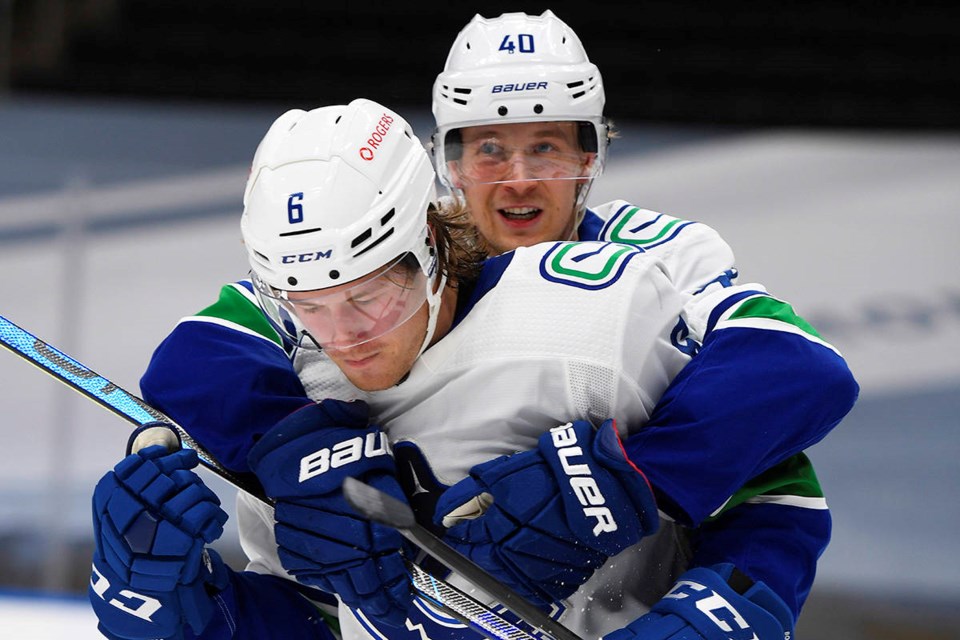For all the hemming and hawing about the Vancouver Canucks’ power play this season, it might surprise some that they’re actually ranked right in the middle of the NHL.
The Canucks are currently 16th in the NHL in power play percentage, 16th in shot rate, and 11th in power play goals per game. Their power play isn’t bad or good — it’s average.
Some might point to the first power play unit being a problem but that unit has scored 5 of the Canucks’ 6 power play goals this season, albeit with two coming at 5-on-3. As much as they’ve looked stagnant or struggled to gain the offensive zone, they have put the puck in the net more than a lot of other teams.
Still, after a night when the team went 0-for-5 on the power play in a one-goal game, it’s understandable why the Canucks might want to change things up. After all, this team isn’t supposed to be average on the power play — with players like Quinn Hughes, Elias Pettersson, Bo Horvat, and Brock Boeser in their core, not to mention new additions Oliver Ekman-Larsson and Conor Garland, they should be well above-average.
“We obviously need to make a difference,” said Brock Boeser. “Being 0-for-5 last night is obviously a difference-maker in the game.”
With that in mind, it’s understandable that the Canucks tried something different at Friday’s practice in Burnaby.
All-new combinations
The first unit had a whole new look, with only Quinn Hughes and Elias Pettersson staying the same. Boeser, fresh from a stint on the second unit, was back on the top unit but at the left faceoff circle as a shooting option instead of in front of the net.
Replacing Bo Horvat in the middle of the ice, also known as the bumper, was Conor Garland, who played a similar role with the Arizona Coyotes. Instead of Alex Chiasson in front of the net, it was Tanner Pearson.
Oliver Ekman-Larsson played the point on the second unit, with J.T. Miller on the left side, Horvat in the middle, and Jack Rathbone on the right. Chiasson was playing net-front with that unit.
Left out of the special teams segment of practice, Vasily Podkolzin and Nils Höglander worked on receiving passes with, strangely, goaltending coach Ian Clark.
Under head coach Travis Green, the Canucks have tried out power play combinations in practice that have never seen the light of day in an actual game. Asked if these units would see game action on Saturday, Green, ever the poker player, refused to show his cards.
“We have different looks that we've thought of trying as the year goes on. And this is one of them that we might try tomorrow, we might not,” said Green, cryptically.
"Both me and Brock have good one-timers."
It’s easy to see the appeal. Putting Boeser back on the top unit adds another one-timer threat that can pull focus from Pettersson, potentially giving both he and Boeser more room to shoot. Switching the left-shot Horvat for right-shot Garland gives a one-timer option on the inside for Pettersson, giving him an additional option when he has the puck.
With this look, the power play would likely run more through Pettersson rather than previously running primarily through Miller on the left side.
“Both me and Brock have good one-timers,” said Pettersson. “So they have to take away both, then Quinn has a clear lane in the middle. It's just that threat from both sides and if we move the puck fast, which we did today in practice, things will open up.”
“It's exciting,” said Boeser about working with Hughes and Pettersson again. “Obviously, we've worked together before a couple years ago, and I think just having that threat of two one-timers on each side, it's going to be hard [to defend]. And if they take those away, then Huggy has a shot. Then having that righty in the middle too, I think it gives us lots of options.”
Spreading out the centres
One wrinkle in moving Miller and Horvat to the second unit is that Pettersson then becomes the only centre. Miller and Horvat are also the Canucks’ two best players on faceoffs. Pettersson has won just 15 of his 48 faceoffs this season, for a percentage of 31.3%.
It’s frustrating, because that appeared to be a part of his game that was legitimately improving — he was up to 45.0% on faceoffs last season — but he’s struggled on faceoffs this season, like he has in much of his game. If he’s the lone centre on the first power play unit, he’ll have to win faceoffs.
Of course, before this change, the second unit didn't have any centres at all. Now they'll have two.
The new-look second unit retains the left-handed connection between Miller and Horvat, with the right-handed Chiasson available to kick-out down low for the potential tic-tac-toe passing play from Miller to Chiasson to Horvat.
Ekman-Larsson is a solid distributor on the power play and has a hard shot, so he and Miller could potentially work together the same way Miller and Hughes do. Rathbone has a great shot, so he’s available for a one-timer from the top of the right faceoff circle like an off-brand Pettersson.
In other words, the second unit maintains the same looks as the old first unit, just with a couple of different players involved.
Here’s the thing: Miller and Horvat led the Canucks in power play goals last season. If they’re moved to the second unit, they’ll surely get less ice time. Or, maybe not. Maybe the goal is to create two equally-strong power play units that will compete for ice time. Maybe that second unit will start on the power play sometimes.
Are these new units enough to elevate the power play from mediocre to great? Will we even see these units in an actual game? That remains to be seen.



.JPG;w=120;h=80;mode=crop)
